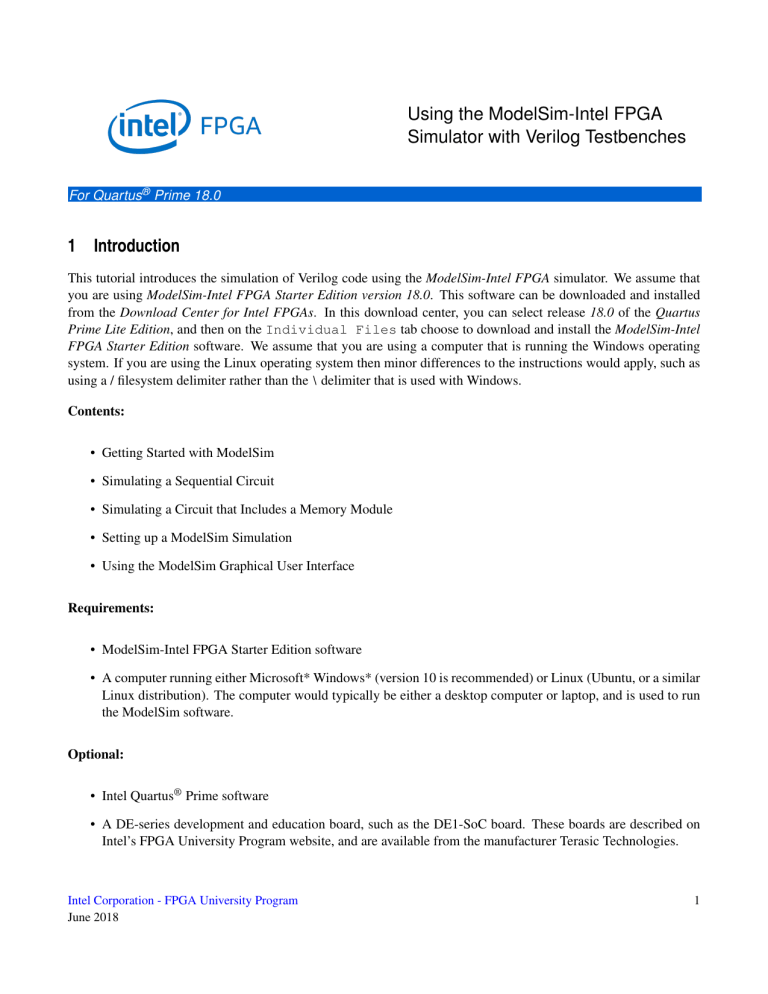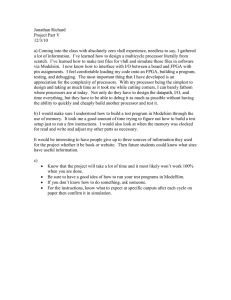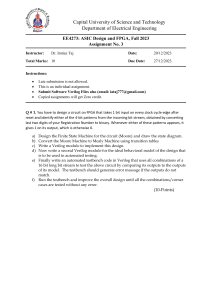
Using the ModelSim-Intel FPGA
Simulator with Verilog Testbenches
For Quartus® Prime 18.0
1
Introduction
This tutorial introduces the simulation of Verilog code using the ModelSim-Intel FPGA simulator. We assume that
you are using ModelSim-Intel FPGA Starter Edition version 18.0. This software can be downloaded and installed
from the Download Center for Intel FPGAs. In this download center, you can select release 18.0 of the Quartus
Prime Lite Edition, and then on the Individual Files tab choose to download and install the ModelSim-Intel
FPGA Starter Edition software. We assume that you are using a computer that is running the Windows operating
system. If you are using the Linux operating system then minor differences to the instructions would apply, such as
using a / filesystem delimiter rather than the \ delimiter that is used with Windows.
Contents:
• Getting Started with ModelSim
• Simulating a Sequential Circuit
• Simulating a Circuit that Includes a Memory Module
• Setting up a ModelSim Simulation
• Using the ModelSim Graphical User Interface
Requirements:
• ModelSim-Intel FPGA Starter Edition software
• A computer running either Microsoft* Windows* (version 10 is recommended) or Linux (Ubuntu, or a similar
Linux distribution). The computer would typically be either a desktop computer or laptop, and is used to run
the ModelSim software.
Optional:
• Intel Quartus® Prime software
• A DE-series development and education board, such as the DE1-SoC board. These boards are described on
Intel’s FPGA University Program website, and are available from the manufacturer Terasic Technologies.
Intel Corporation - FPGA University Program
June 2018
1
U SING THE M ODEL S IM -I NTEL FPGA S IMULATOR WITH V ERILOG T ESTBENCHES
2
For Quartus® Prime 18.0
Getting Started
The ModelSim Simulator is a sophisticated and powerful tool that supports a variety of usage models. In this tutorial
we focus on only one design flow: using the ModelSim software as a stand-alone program to perform functional
simulations, with simulation inputs specified in a testbench, and with simulator commands provided via script files.
Other possible design flows for using ModelSim include invoking it from within the Intel Quartus Prime software,
performing timing simulations, and specifying simulation inputs by drawing waveforms in a graphical editor instead
of using a testbench. These flows are not described here, but can be found in other documentation that is available
on the Internet.
To introduce the ModelSim software, we will first open an existing simulation example. The example is a multibit
adder named Addern, and is included as part of the design files provided along with this tutorial. Copy the Addern
files to a folder on your computer, such as C:\ModelSim_Tutorial\Addern. In the Addern folder there is a Verilog
source-code file called Addern.v and a subfolder named ModelSim. The Addern.v file, shown in Figure 1, is the
Verilog code that will be simulated in this part of the tutorial. We will specify signal values for the adder’s inputs,
Cin, X, and Y, and then the ModelSim simulator will generate corresponding values for the outputs, Sum and Cout.
// A multi-bit adder
module Addern (Cin, X, Y, Sum, Cout);
parameter n = 16;
input Cin;
input [n-1:0] X, Y;
output [n-1:0] Sum;
output Cout;
assign {Cout, Sum} = X + Y + Cin;
endmodule
Figure 1. Verilog code for the multibit adder.
We will use three files included in the ModelSim subfolder to control the ModelSim simulator. The files are named
testbench.v, testbench.tcl, and wave.do.
The testbench.v file is a style of Verilog code known as a testbench. The purpose of a testbench is to instantiate a
Verilog module that is to be simulated, and to specify values for its inputs at various simulation times. In this case the
module to be simulated is our multibit adder, which we refer to as the design under test (DUT). The first statement
in the Verilog testbench, illustrated in Figure 2, is called a timescale compiler directive. Its first argument sets the
units of simulation time to 1 nanosecond. The user can specify values for the inputs to the DUT in terms of these
time units, as we will illustrate shortly. The second argument sets the resolution of the simulation to 1 picosecond.
This parameter specifies the granularity of time for which ModelSim evaluates signal values during a simulation.
We will use these parameters for all of our simulations in this tutorial.
Line 2 is the start of the testbench module, which has no inputs or outputs. In Lines 4 and 5 we declare the signals
Cin, X, and Y, which will be used as the inputs to the DUT. Values will be assigned at various simulation times to
these signals in the testbench code. Verilog syntax requires that these signals have the type reg as given in the figure.
When a value is specified in the testbench code for a signal with the reg type, the signal maintains this value until
2
Intel Corporation - FPGA University Program
June 2018
U SING THE M ODEL S IM -I NTEL FPGA S IMULATOR WITH V ERILOG T ESTBENCHES
For Quartus® Prime 18.0
it is changed again in the testbench. Lines 7 and 8 in Figure 2 declare the signals Sum and Cout, which will be
connected to the outputs of the DUT. These signals, whose values are determined by the behavior of the DUT during
the simulation, have to be declared with the type wire as given in the code.
The Addern module, our design under test, is instantiated in Line 11 of the testbench. The Addern inputs and outputs
are attached to the signals declared previously in Lines 4 to 8 of the testbench.
Lines 14 to 22 provide an initial block. It is is used to assign values to the reg signals that provide inputs to the DUT.
The initial block starts executing at the beginning of simulation time, so that line 16 initializes the signals X, Y, and
Cin to 0 at simulation time 0. Line 17 specifies that after 20 simulation time units the value of the input Y changes
to 10. Since the unit of simulation time is set to 1 ns by the timescale directive in Line 1, this means that Y changes
to the value 10 at 20 ns in simulation time. Line 18 specifies that after another 20 ns, meaning at 40 ns in simulation
time, input X changes to 10. The rest of the initial block specifies various values for the adder inputs at 20 ns time
increments.
1
2
3
4
5
6
7
8
9
10
11
12
13
14
15
16
17
18
19
20
21
22
23
‘timescale 1ns / 1ps
module testbench ( );
// reg signals provide inputs to the design under test
reg Cin;
reg [15:0] X, Y;
// wire signals are used for outputs
wire [15:0] Sum;
wire Cout;
// instantiate the design under test
Addern U1 (Cin, X, Y, Sum, Cout);
// assign signal values at various simulation times
initial
begin
X <= 0; Y <= 0; Cin <= 0;
#20 X <= 0; Y <= 10; Cin <= 0;
#20 X <= 10; Y <= 10; Cin <= 0;
#20 X <= 10; Y <= 10; Cin <= 1;
#20 X <= 16’hFFF0; Y <= 16’hF; Cin <= 0;
#20 X <= 16’hFFF0; Y <= 16’hF; Cin <= 1;
end // initial
endmodule
Figure 2. The Verilog testbench code.
Open the ModelSim software to reach the window shown in Figure 3. Click on the Transcript window at the bottom
of the figure and then use the cd command to navigate to the ModelSim folder for the multibit adder. For example,
in our case we would type cd C:/ModelSim_Tutorial/Addern/ModelSim. Note that ModelSim uses the
/ symbol to navigate between filesystem folders, even though the Windows operating system uses the \ symbol for
this purpose. Next, we wish to run a series of simulator commands that are included in the script file testbench.tcl.
Intel Corporation - FPGA University Program
June 2018
3
U SING THE M ODEL S IM -I NTEL FPGA S IMULATOR WITH V ERILOG T ESTBENCHES
For Quartus® Prime 18.0
Figure 3. The ModelSim window.
Figure 4 shows the contents of the script testbench.tcl. First, the quit command is invoked to ensure that no
simulation is already running. Then, in Line 4 the vlib command is executed to create a work design library;
ModelSim stores compilation/simulation results in this working library. The Verilog compiler is invoked in Line 7
to compile the source code for the Addern module, which is in the parent folder (../), and in Line 9 to compile
testbench.v in the current folder. The simulation is started by the vsim command in Line 11. It includes some
simulation libraries for Intel FPGAs that may be needed by ModelSim. If the included libraries aren’t required for
the current design, then they will be ignored during the simulation. Line 13 in Figure 4 executes the command
do wave.do. The do command is used to execute other ModelSim commands provided in a file. In this case the
file wave.do, which will be described shortly, contains various commands that are used to configure the ModelSim
waveform-display window. The final command in Figure 6 advances the simulation by a desired amount of time,
which in this case is 120 ns.
To run the script, in the Transcript window type the command do testbench.tcl. ModelSim will execute the
commands in this script and then update its graphical user interface to show the simulation results. The updated
ModelSim window after running the testbench.tcl script is illustrated in Figure 5.
4
Intel Corporation - FPGA University Program
June 2018
U SING THE M ODEL S IM -I NTEL FPGA S IMULATOR WITH V ERILOG T ESTBENCHES
1
2
3
4
5
6
7
8
9
10
11
12
13
14
15
For Quartus® Prime 18.0
# stop any simulation that is currently running
quit -sim
# create the default "work" library
vlib work;
# compile the Verilog source code in the parent folder
vlog ../*.v
# compile the Verilog code of the testbench
vlog *.v
# start the Simulator, including some libraries
vsim work.testbench -Lf 220model -Lf altera_mf_ver -Lf
verilog
# show waveforms specified in wave.do
do wave.do
# advance the simulation the desired amount of time
run 120 ns
Figure 4. The testbench.tcl file.
Figure 5. The updated ModelSim window.
Intel Corporation - FPGA University Program
June 2018
5
U SING THE M ODEL S IM -I NTEL FPGA S IMULATOR WITH V ERILOG T ESTBENCHES
For Quartus® Prime 18.0
The wave.do file used for this design example appears in Figure 6. It specifies in Lines 3 to 12 which signal
waveforms should be displayed in the simulation results, and also includes a number of settings related to the display.
To add or delete waveforms in the display you can manually edit the wave.do file using any text editor, or you can
select which waveforms should be displayed by using the ModelSim graphical user interface. Referring to Figure 5,
changes to the displayed waveforms can be selected by right-clicking in the waveform window. Waveforms can
be added to the display by selecting a signal in the Objects window and then dragging-and-dropping that signal
name into the Wave window. A more detailed discussion about commands available in the graphical user interface
is provided in Appendix A.
Quit the ModelSim software to complete this part of the tutorial. To quit the program you can either select the
File > Quit command, or type exit in the Transcript window, or just click on the X in the upper-right corner of
the ModelSim window.
1
2
3
4
5
6
7
8
9
10
11
12
13
14
15
16
17
18
19
20
21
22
23
24
25
26
27
28
29
30
onerror {resume}
quietly WaveActivateNextPane {} 0
add wave -noupdate -label Cin /testbench/Cin
add wave -noupdate -label X -radix hexadecimal /testbench/X
add wave -noupdate -label Y -radix hexadecimal /testbench/Y
add wave -noupdate -label Cout /testbench/Cout
add wave -noupdate -divider Adder
add wave -noupdate -label Cin /testbench/U1/Cin
add wave -noupdate -label X -radix hexadecimal /testbench/U1/X
add wave -noupdate -label Y -radix hexadecimal /testbench/U1/Y
add wave -noupdate -label Sum -radix hexadecimal /testbench/U1/Sum
add wave -noupdate -label Cout /testbench/U1/Cout
TreeUpdate [SetDefaultTree]
WaveRestoreCursors {{Cursor 1} {20000 ps} 0}
quietly wave cursor active 1
configure wave -namecolwidth 73
configure wave -valuecolwidth 64
configure wave -justifyvalue left
configure wave -signalnamewidth 0
configure wave -snapdistance 10
configure wave -datasetprefix 0
configure wave -rowmargin 4
configure wave -childrowmargin 2
configure wave -gridoffset 0
configure wave -gridperiod 1
configure wave -griddelta 40
configure wave -timeline 0
configure wave -timelineunits ns
update
WaveRestoreZoom {0 ps} {120 ns}
Figure 6. The wave.do file.
6
Intel Corporation - FPGA University Program
June 2018
U SING THE M ODEL S IM -I NTEL FPGA S IMULATOR WITH V ERILOG T ESTBENCHES
3
For Quartus® Prime 18.0
Simulating a Sequential Circuit
Another ModelSim example, called Accumulate, is included as part of the design files for this tutorial. Copy the
Accumulate example to a folder on your computer, such as C:\ModelSim_Tutorial\Accumulate. In the Accumulate
folder there is a Verilog source-code file called Accumulate.v and a subfolder named ModelSim. The Accumulate.v
file, which provides the Verilog code that we will simulate, is shown in Figure 7. It represents the logic circuit
illustrated in Figure 8, which includes an adder, register, and down-counter. The purpose of this circuit is to add
together, or accumulate, values of the input X for each clock cycle until the counter reaches zero.
The Accumulate module in Figure 7 has ports KEY, CLOCK_50, SW, and LEDR because the module is intended to
be implemented on a DE-series board that features an Intel FPGA, such as the DE1-SoC board. After simulating the
Verilog code to verify its correct operation, you may wish to compile it using the Quartus Prime CAD tools and then
download and test the resulting circuit on a board.
module Accumulate (KEY, CLOCK_50, SW, LEDR);
input [0:0] KEY;
input CLOCK_50;
input [9:0] SW;
output [9:0] LEDR;
wire Clock, Resetn, z;
wire [4:0] X, Y;
reg [9:0] Sum;
reg [4:0] Count;
assign
assign
assign
assign
Clock = CLOCK_50;
Resetn = KEY[0];
X = SW[4:0];
Y = SW[9:5];
always @(posedge Clock)
if (Resetn == 1’b0)
Sum <= 0;
else if (z == 1’b1)
Sum <= Sum + X;
// synchronous clear of the accumulator
always @(posedge Clock)
if (Resetn == 1’b0)
// synchronous load of the counter
Count <= Y;
else if (z == 1’b1)
Count <= Count - 1’b1;
assign z = | Count;
assign LEDR = Sum;
endmodule
Figure 7. Verilog code for the accumulator.
Intel Corporation - FPGA University Program
June 2018
7
U SING THE M ODEL S IM -I NTEL FPGA S IMULATOR WITH V ERILOG T ESTBENCHES
Resetn
Clock
Y
For Quartus® Prime 18.0
X
5
5
E
L
E
Down-Counter
Resetn
Register
10
Sum
Figure 8. The accumulator circuit.
A testbench.v file for the accumulator design under test (DUT) is given in Figure 9. Three reg-type signals, KEY,
CLOCK_50, and SW are declared to provide inputs to the DUT, as well as a wire-type signal LEDR for connecting
to the DUT outputs. The Accumulate module is instantiated in Line 12.
It is useful to define a periodic signal that can be used as a clock input for the Accumulate sequential circuit. We
could manually define some number of cycles for such a signal by using an initial block in the testbench, but this
method would be awkward. Instead, Lines 15 to 16 in Figure 9 show how a clock signal can be easily specified
by using an always block. Unlike an initial block, in which the statements are executed just once in sequential
order, the statements in an always block are executed repeatedly. Thus, Line 16 in the always block inverts the
CLOCK_50 signal every 10 ns in simulation time and creates a 50 MHz periodic waveform. The always block is
executed concurrently by the Simulator along with the initial block in Lines 18 to 26. This code first initializes the
CLOCK_50 signal to 0 at the start of the simulation. This action is necessary because the default value of a reg-type
signal is X (unknown value), which cannot be inverted in the always block. The initial block also sets KEY0 = 0 and
SW= 0 at the start of the simulation, which allows the Sum in the accumulator to be cleared. At 20 ns in simulation
time SW9−5 is set to 10, so that this value can be loaded into the counter. Finally, at 40 ns in simulation time KEY0 is
set to 1 and SW4−0 is set to 30, so that this value can be accumulated for each clock cycle until the counter reaches 0.
Reopen the ModelSim software to get to the window in Figure 3. Click on the Transcript window at the bottom
of the figure and then use the cd command to navigate to the ModelSim folder for the accumulator. For example,
in our case we would type cd C:/ModelSim_Tutorial/Accumulate/ModelSim. Then, in the Transcript
window type the command do testbench.tcl as you did for the previous example. The testbench.tcl script for
this example is identical to the one shown in Figure 4, except that the last line specifies run 300 ns.
8
Intel Corporation - FPGA University Program
June 2018
U SING THE M ODEL S IM -I NTEL FPGA S IMULATOR WITH V ERILOG T ESTBENCHES
1
2
3
4
5
6
7
8
9
10
11
12
13
14
15
16
17
18
19
20
21
22
23
24
25
26
27
For Quartus® Prime 18.0
‘timescale 1ns / 1ps
module testbench ( );
// reg signals to provide inputs to the DUT
reg [0:0] KEY;
reg CLOCK_50;
reg [9:0] SW;
// wire signals to connect to outputs from the DUT
wire [9:0] LEDR;
// instantiate the design under test
Accumulate U1 (KEY, CLOCK_50, SW, LEDR);
// generate a 50 MHz periodic clock waveform
always
#10 CLOCK_50 <= ~CLOCK_50;
initial
begin
CLOCK_50 <= 1’b0;
KEY[0] <= 1’b0;
SW <= 0;
#20 SW[9:5] <= 10;
#20 KEY[0] <= 1’b1;
SW[4:0] <= 30;
end // initial
endmodule
Figure 9. The Verilog testbench code for the sequential circuit.
The simulation results for our sequential circuit, which display the waveforms selected in its wave.do file, appear in
Figure 10. In this figure the SW and LEDR signals are displayed in hexadecimal, while X, Sum, Y, and Count are
displayed as unsigned (decimal) values. The Sum is cleared by the clock edge at 10 ns, and the Count is initialized
to 10 at 30 ns. Starting with the clock edge at 50 ns the value X = 30 is accumulated until the counter reaches 0.
Quit the ModelSim software to complete this part of the tutorial.
4
Simulating a Circuit that Includes a Memory Module
The design files archive provided along with this tutorial includes a ModelSim example called Display. It shows
how to instantiate a memory module in Verilog code, and how to initialize the stored contents of the memory in a
ModelSim simulation. Copy the Display files to a folder on your computer, such as C:\ModelSim_Tutorial\Display.
In the Display folder there is a file called Display.v that provides the Verilog code that we will simulate, and a
subfolder named ModelSim.
Intel Corporation - FPGA University Program
June 2018
9
U SING THE M ODEL S IM -I NTEL FPGA S IMULATOR WITH V ERILOG T ESTBENCHES
For Quartus® Prime 18.0
Figure 10. The simulation results for our sequential circuit.
Figure 11 shows the Verilog code for Display.v. Its ports are named KEY, SW, HEX0, and LEDR because the module
is intended to be implemented on a DE-series board that features an Intel FPGA, such as the DE1-SoC board. After
simulating the Verilog code to verify its correct operation, you may wish to compile it using the Quartus Prime CAD
tools and then download and test the resulting circuit on a board.
Figure 12a gives a logic circuit that corresponds to the code in Figure 11. The circuit contains a counter that is used
to read the contents of successive addresses from a memory. This memory provides codes in ASCII format for some
upper- and lower-case letters, which are provided as inputs to a decoder module. The counter and memory module
have a common clock signal, and the counter has a synchronous clear input. Each successive clock cycle advances
the counter and reads a new ASCII code from the memory. Since the counter is three-bits wide, only the first eight
locations in the memory are read (the upper two address bits on the memory are set to 00), and they provide the
ASCII codes for letters A, b, C, d, E, F, g, and h. The decoder produces an appropriate bit-pattern to render each
letter on a seven-segment display. The memory used in the logic circuit is depicted in part b of Figure 12. It is
a 32 × 8 synchronous read-only memory (ROM), which has a register for holding address values. The memory is
initialized with the contents of the file inst_mem.mif, which is illustrated in Figure 13. This file contains the ASCII
codes for the eight letters displayed by the circuit.
A testbench.v file for the Display design under test (DUT) is given in Figure 14. Two reg-type signals, KEY and SW
are declared to provide inputs to the DUT, as well as two wire-type signals HEX0 and LEDR for connecting to the
DUT outputs. The DUT is instantiated in Line 9 of the testbench. It uses an always block to create a clock waveform
with a 20 ns period on the KEY signal. An initial block is used to initialize the KEY clock waveform to 0, and to
perform a synchronous reset of the counter with the SW signal.
Figure 15 shows the contents of the script testbench.tcl for this example. It has the same structure as the file shown in
Figure 4, with two exceptions. First, in Lines 5 to 8 the script checks whether there exists an inst_mem.mif memory
initialization file in the parent folder; if so, it copies this file to the ModelSim folder so that the memory will be
properly initialized during simulation. Second, in Lines 10 to 12 the script checks if an “empty black box” file,
10
Intel Corporation - FPGA University Program
June 2018
U SING THE M ODEL S IM -I NTEL FPGA S IMULATOR WITH V ERILOG T ESTBENCHES
For Quartus® Prime 18.0
module Display (KEY, SW, HEX0, LEDR);
input [0:0] KEY;
input [0:0] SW;
output reg [6:0] HEX0;
output [9:0] LEDR;
parameter A = 8’d65, b = 8’d98, C = 8’d67, d = 8’d100, E = 8’d69,
F = 8’d70, g = 8’d103, h = 8’d104;
wire Resetn, Clock;
wire [2:0] Count;
wire [7:0] char;
assign Resetn = SW[0];
assign Clock = KEY[0];
count3 U1 (Resetn, Clock, Count);
inst_mem U2 ({2’b0, Count}, Clock, char);
assign LEDR = {2’b0, char};
always @(*)
case (char)
A: HEX0
b: HEX0
C: HEX0
d: HEX0
E: HEX0
F: HEX0
g: HEX0
h: HEX0
default
endcase
endmodule
= 7’b0001000;
= 7’b0000011;
= 7’b1000110;
= 7’b0100001;
= 7’b0000110;
= 7’b0001110;
= 7’b0010000;
= 7’b0001011;
HEX0 = 7’b1111111;
module count3 (Resetn, Clock, Q);
input Resetn, Clock;
output reg [2:0] Q;
always @ (posedge Clock, negedge Resetn)
if (Resetn == 0)
Q <= 3’b000;
else
Q <= Q + 1’b1;
endmodule
Figure 11. Verilog code for the display circuit.
which can optionally be created by the Quartus software, exists in the parent directory. If so, the script deletes this
file, because it would cause an error during simulation.
Intel Corporation - FPGA University Program
June 2018
11
U SING THE M ODEL S IM -I NTEL FPGA S IMULATOR WITH V ERILOG T ESTBENCHES
Counter
Memory
Decoders
0
00
Q
For Quartus® Prime 18.0
5
3
addr
data
8
char
seg7
7
5
6
4
1
2
3
Resetn
Clock
a) circuit
Address
5
5
32 x 8
8
DataOut
ROM
b) memory module
Figure 12. The circuit for the memory example.
DEPTH = 32;
WIDTH = 8;
ADDRESS_RADIX = HEX;
DATA_RADIX = DEC;
CONTENT
BEGIN
00 : 65;
%A%
01 : 98;
%b %
02 : 67;
%C%
03 : 100;
%d %
04 : 69;
%E %
05 : 70;
%F %
06 : 103;
%g %
07 : 104;
%h %
END;
Figure 13. The inst_mem.mif memory initialization file.
12
Intel Corporation - FPGA University Program
June 2018
U SING THE M ODEL S IM -I NTEL FPGA S IMULATOR WITH V ERILOG T ESTBENCHES
1
2
3
4
5
6
7
8
9
10
11
12
13
14
15
16
17
18
19
20
21
22
For Quartus® Prime 18.0
‘timescale 1ns / 1ps
module testbench ( );
reg [0:0] KEY;
reg [0:0] SW;
wire [6:0] HEX0;
wire [9:0] LEDR;
Display U1 (KEY, SW, HEX0, LEDR);
always
begin : Clock_Generator
#10 KEY <= ~KEY;
end
initial
begin
KEY <= 1’b0;
SW <= 1’h0;
#20 SW[0] <= 1’b1;
end // initial
endmodule
Figure 14. Testbench code for the memory example.
Reopen the ModelSim software to get to the window in Figure 3. In the Transcript window use the cd command to navigate to the ModelSim folder for the this part of the tutorial. For example, in our case we would
type cd C:/ModelSim_Tutorial/Display/ModelSim. In the Transcript window type the command do
testbench.tcl to run the script in Figure 15. The simulation results for our circuit, which display the waveforms
selected in its wave.do file, appear in Figure 16. It shows in the char waveform, displayed using the “radix” ASCII,
the values read from each address in memory. These values are also shown in hexadecimal in the LEDR waveform,
and the decoder outputs are shown in binary in the HEX0 waveform.
5
Setting up a ModelSim Simulation
The files described above can be used as a starting point for setting up your own ModelSim simulation, as follows. In
the folder that contains your Verilog source-code to be simulated, make a subfolder named ModelSim. Copy into this
subfolder the files testbench.v, testbench.tcl, and wave.do from one of the examples above. Then, modify testbench.v
to instantiate your top-level Verilog module and create whatever waveforms are needed. You can use an identical
testbench.tcl script as shown above, except that you might want to specify a different amount of simulation time for
the run command. Since the .v and .tcl files are ASCII text files, you can edit them with any text editor of your
choosing (or the text editor provided within ModelSim). Finally, modify the wave.do file to choose the waveforms
that should be displayed. You can change the wave.do file manually by editing it with a text editor, or you can make
use of the commands available in the ModelSim graphical user interface, as discussed in Appendix A.
Intel Corporation - FPGA University Program
June 2018
13
U SING THE M ODEL S IM -I NTEL FPGA S IMULATOR WITH V ERILOG T ESTBENCHES
1
2
3
4
5
6
7
8
9
10
11
12
13
14
15
16
17
18
19
20
21
22
23
24
25
For Quartus® Prime 18.0
# stop any simulation that is currently running
quit -sim
# if simulating with a MIF file, copy it. Assumes
inst_mem.mif
if {[file exists ../inst_mem.mif]} {
file delete inst_mem.mif
file copy ../inst_mem.mif .
}
# if Quartus generated an "empty black box" file, delete it
if {[file exists ../inst_mem_bb.v]} {
file delete ../inst_mem_bb.v
}
# create the default "work" library
vlib work;
# compile the Verilog source code in the parent folder
vlog ../*.v
# compile the Verilog code of the testbench
vlog *.v
# start the Simulator, including some libraries
vsim work.testbench -Lf 220model -Lf altera_mf_ver -Lf
verilog
# show waveforms specified in wave.do
do wave.do
# advance the simulation the desired amount of time
run 120 ns
Figure 15. The testbench.tcl file.
Figure 16. The simulation results for our memory example.
14
Intel Corporation - FPGA University Program
June 2018
U SING THE M ODEL S IM -I NTEL FPGA S IMULATOR WITH V ERILOG T ESTBENCHES
For Quartus® Prime 18.0
Appendix A: Using the ModelSim Graphical User Interface
This appendix illustrates some of the features available in the ModelSim graphical user interface for displaying
waveforms. We will show how to add waveforms to the ModelSim window, and how to change the properties of a
waveform, such as its displayed name and number radix.
As an example we will show how waveforms can be added to the ModelSim display for the accumulator circuit
from the previous section. Figure 17 displays the ModelSim window for this circuit before any waveforms have
been selected.
Figure 17. The ModelSim waveform display.
In Figure 18 we have selected a waveform, as follows. First, we clicked on the testbench module in the upper left
part of the display. As a result of this action the signals that exist in the selected module are listed in the Objects
pane (the area with the dark blue background). In this list we then used the left mouse button to drag-and-drop the
KEY signal name from the Objects list into the Wave window. Then, as illustrated in the figure, we right-clicked
on the name of the signal in the Wave display, which is /testbench/KEY, and then clicked on Properties to
open the window in Figure 19.
In Figure 19 we assigned the name KEY to the waveform, clicked Apply and then closed this dialogue. We then used
the same drag-and-drop mechanism to add the signals CLOCK_50, SW, and LEDR from the testbench module to
the Wave window, and set convenient display names for these waveforms. The updated Wave window is shown in
Figure 20.
Next, we wish to add signals from the Accumulate module to the Wave window. But first we can add a divider, as
a visual aid that separates the testbench signals and the Accumulate module signals. A divider can be added
by right-clicking on the Wave window, as indicated in the Figure 21, clicking on Add in the pop-up menu, and then
selecting New Divider to open the window in Figure 22.
We assigned Accumulate as the divider name in Figure 22, and then closed this dialogue. The Wave window now
appears as shown in Figure 23.
Intel Corporation - FPGA University Program
June 2018
15
U SING THE M ODEL S IM -I NTEL FPGA S IMULATOR WITH V ERILOG T ESTBENCHES
For Quartus® Prime 18.0
Figure 18. Adding a waveform from the testbench module.
Figure 19. Specifying a display name for a waveform.
To add signals from the Accumulate module to the Wave window we need to click on the U1 instance name of
the Accumulate model, as indicated on the left-hand side of Figure 24. The signals available in this module are
then listed in the Objects pane. To obtain the display in the figure, we used the drag-and-drop mechanism, and
the Wave Properties dialogue, described previously, to add the Clock, Resetn, X, Sum, Y, Count, and z
16
Intel Corporation - FPGA University Program
June 2018
U SING THE M ODEL S IM -I NTEL FPGA S IMULATOR WITH V ERILOG T ESTBENCHES
For Quartus® Prime 18.0
signals to the Wave window. We now wish to perform a simulation of our testbench so that waveforms will be
generated and shown for our selected signals. However, it is critical to first save the selections that have been made
Figure 20. The waveform display after adding more testbench signals.
Figure 21. Adding a divider to the waveform display.
Intel Corporation - FPGA University Program
June 2018
17
U SING THE M ODEL S IM -I NTEL FPGA S IMULATOR WITH V ERILOG T ESTBENCHES
For Quartus® Prime 18.0
Figure 22. Assigning a name to the divider.
Figure 23. The waveform display after adding the Accumulate divider.
in the Wave display to the wave.do file. If you run a simulation without first performing a save to the wave.do file,
then all changes made to the Wave window will be discarded and lost!
The command File > Save Format opens the dialogue shown in Figure 25. After clicking OK and then overwriting the wave.do file, the testbench simulation can be executed by typing the command do testbench.tcl.
The resulting waveform display is illustrated in Figure 26. In this figure we right-clicked on the Wave window and
selected Zoom Range to open the dialogue in Figure 27. As indicated in the figure, we select a time range from 0
to 300 ns for the Wave display.
18
Intel Corporation - FPGA University Program
June 2018
U SING THE M ODEL S IM -I NTEL FPGA S IMULATOR WITH V ERILOG T ESTBENCHES
For Quartus® Prime 18.0
Figure 24. The waveform display after adding signals from the accumulate module.
Figure 25. The Save Format dialogue.
Figure 26. The display after running the simulation; changing the zoom range.
Intel Corporation - FPGA University Program
June 2018
19
U SING THE M ODEL S IM -I NTEL FPGA S IMULATOR WITH V ERILOG T ESTBENCHES
For Quartus® Prime 18.0
Figure 27. Inputting the zoom range.
Figure 28. Setting the radix for a waveform.
Figure 29. The final waveform display.
20
Intel Corporation - FPGA University Program
June 2018
U SING THE M ODEL S IM -I NTEL FPGA S IMULATOR WITH V ERILOG T ESTBENCHES
For Quartus® Prime 18.0
To make it easier to see the values of signals in the Wave window, you can select radices other than binary, which
is the default. For example, in Figure 28 we right-clicked on the SW signal, clicked on Radix, and then selected
Hexadecimal. After setting the radix to hexadecimal for several additional signals, the final Wave display appears
as illustrated in Figure 29. As mentioned earlier, changes to the waveforms have to be saved by using the File >
Save Format command.
This tutorial has described only a subset of the commands that are provided in the ModelSim graphical user interface.
Although a discussion of other available commands is beyond the scope of this tutorial, a number of more detailed
ModelSim tutorials can be found by searching for them on the Internet.
Intel Corporation - FPGA University Program
June 2018
21




